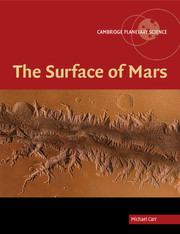12 - Climate change
Published online by Cambridge University Press: 12 August 2009
Summary
Throughout this book we have described features on the surface that almost certainly imply that climatic conditions in the past were different from those that prevail today. Among others, these include valley networks, lakes, oceans, deltas, hydrated minerals, water-lain sediments, evaporites, glacial deposits, ice-rich veneers, and ice at low latitudes. In this chapter we briefly re-examine what these features might imply about the climatic history of the planet and explore what might have caused the climatic variations.
The discussion is broken down into three pieces. The first piece of the story is the Noachian. This is the era for which we have the best evidence for dramatically warmer climatic conditions. The main evidence is the presence of valley networks, seemingly formed by slow erosion of running water. But warmer conditions are also implied by high erosion rates, indications of lakes, deltas, and water-lain sediments, and detection of hydrous minerals. The second part of the story concerns the post-Noachian era. The geological evidence here is more conflicting. While the mineralogical evidence and the bulk of the geomorphic evidence suggest persistent cold conditions, there may have been occasional climatic excursions. We will look at the evidence for such excursions and examine possible causes. The third part of the story concerns geologically recent changes that have been induced by obliquity variations. These were discussed in Chapters 8 and 10 and will be summarized only briefly here.
- Type
- Chapter
- Information
- The Surface of Mars , pp. 257 - 266Publisher: Cambridge University PressPrint publication year: 2007

